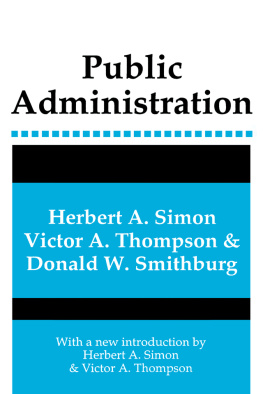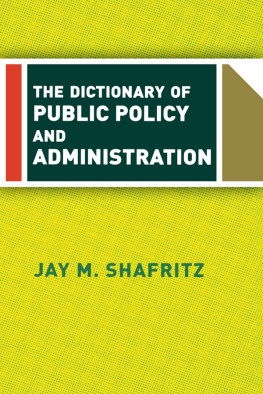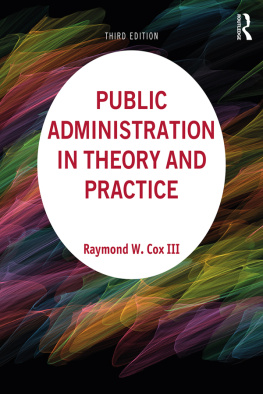Originally published in 1950 by Alfred A. Knopf, Inc
Published 1991 by Transaction Publishers
Published 2017 by Routledge
2 Park Square, Milton Park, Abingdon, Oxon OX14 4RN
711 Third Avenue, New York, NY 10017, USA
Routledge is an imprint of the Taylor & Francis Group, an informa business
New material this edition copyright 1991 by Taylor & Francis.
All rights reserved. No part of this book may be reprinted or reproduced or utilised in any form or by any electronic, mechanical, or other means, now known or hereafter invented, including photocopying and recording, or in any information storage or retrieval system, without permission in writing from the publishers.
Notice:
Product or corporate names may be trademarks or registered trademarks, and are used only for identification and explanation without intent to infringe.
Library of Congress Catalog Number: 90-22822
Library of Congress Cataloging-in-Publication Data
Simon, Herbert Alexander, 1916
Public administration/Herbert A. Simon, Donald W. Smithburg, Victor
A. Thompson,
p. cm.
Originally published: New York: Alfred A. Knopf, 1950.
Includes bibliographical references and index.
ISBN 0-88738-895-7
1. Public administration. I. Smithburg, Donald W., 1916-90.
II. Thompson, Victor Alexander. III. Title.
JF1351.S5 1991
350dc20
90-22822
ISBN 13: 978-0-88738-895-8 (pbk) CIP
When the project of reissuing Public Administration was broached, our colleague, Don Smithburg was suffering from an illness that in a short time took him from us. Before his death, he expressed his enthusiasm for the project, and we, the two remaining authors, are glad that we could carry it forward. Accordingly we are dedicating this volume to his memory, and to the memory of the exciting times we three had together as colleagues and as friends.
WE ARE pleased to reintroduce our textbook, Public Administration , to readers of a new generation. Our book, published in 1950 and never revised, had a successful life of twenty-seven years in print, not at the head of the best-seller list, but selling an approximate thousand copies each year for a total sale of over 30,000. This is a curious history for a textbook, suggesting that Public Administration played a special role in its field, not only instructing students, but also providing new ideas and pointing new directions for teachers and researchers.
The book had a following abroad as well as in the United States, for it was translated into Spanish (twice: 1954 in Central America, 1968 in Mexico), Chinese (Taiwan, 1959), Japanese (1977), andselected portionsTurkish (1954) and Persian (1956). We might be tempted to claim some share in the Taiwanese and Japanese "miracles," but then we would have to explain why events did not go so well in some of the other parts of the world where we have been read.
Published just after the end of World War II, Public Administration helped to redefine its field of study and practice by introducing two major new emphases: an emphasis upon human behavior and human relations in organizations, and an emphasis upon the interaction between administration and policy (including in the latter, politics). Without neglecting the more traditional concerns with organization structure, it viewed administration in its behavioral and political contexts. The combination of these new contexts with the traditional one is announced by the authors at the beginning of their 1950 preface.
Comparing Public Administration with the textbooks that were contemporary with it, we see that its viewpoints were indeed new in 1950; and comparing it with today's textbooks, we see that these viewpoints still lie in the center of public administration's concern. Of course, we do not wish to suggest that nothing has changed in the world, or that we would not write a different book today; but we are gratified that our book retains, after forty years, such a modern tone.
Modern, with one important exception: the book is loaded with organizational examples, especially at the level of the Federal government, to illustrate or provide evidence for our general principles. Some of these examples refer to organizations that have gone the way of the dinosaurs, although not always without leaving descendants. To help readers whose minds recall the Great Depression and World War II less vividly than ours do, we have provided for this edition a brief appendix describing organizational changes since 1950 that affect Federal organization units mentioned in the text.
While some of the organizations we use for illustration no longer exist or are changed, there is nothing outmoded about the lessons that the examples teach. Since our book is not a manual describing the Federal government but an analysis of human behavior in organizations, the exact dates of the events we recount have nothing to do with the significance of the administrative phenomena they exemplify. Readers will find nothing dated in these events.
Readers will perhaps be gratified, relieved, or even horrified, to learn that the Internal Revenue Service is not a wholly different organization from the sometime Bureau of Internal Revenue, or the Social Security Administration from the late Federal Security Agency. Students may, in fact, find it an instructive exercise to trace the post-1950 changes in some of these agencies, to see whether their histories bear out what the text has to say about the processes of reorganization.
Trends in Administrative Theory
A word or two about each of the book's three main themesorganization structure, human relations, and administration and policy. What have been the main developments in these domains in the past 40 years?
Organization Structure
Public administration has both drawn from and contributed to the mainstream of research on organizations that embraced the private as well as the public sectors. Perhaps the last general summing up was the Handbook of Organizations edited by James G. March, but that is already twenty-five years old. Of course we can get more recent views of the scene from the writings of such prominent figures as March or Henry Mintzberg.
Contingency Theory. Our book predated the appearance of "contingency theory," a term widely used since the 1960s, but examination of the text shows that we were fully sensitive to the fact that, to be effective, organizations must shape themselves to the environments in which they do their workthe main lesson of contingency theory.
Self-Contained and Unitary Organizations. Two innovations in our book that we thought quite important have not been taken up by the field. We still think them important, and would like to call attention to them again. In our chapter on large organizations, we have a good deal to say about self-contained organizations, and about unitary organizations. (Perhaps it would have been better to talk about degree of self-containment of organizations, and the extent to which an organization is unitary.)
Self-containment determines how far an organizational unit is master of its own fate, and can proceed with its decisions without extensive consultation and negotiation with other units. Degree of self-containment is a principal determinant of the ease with which an organization can innovate, and exercises a major influence on leadership style.











